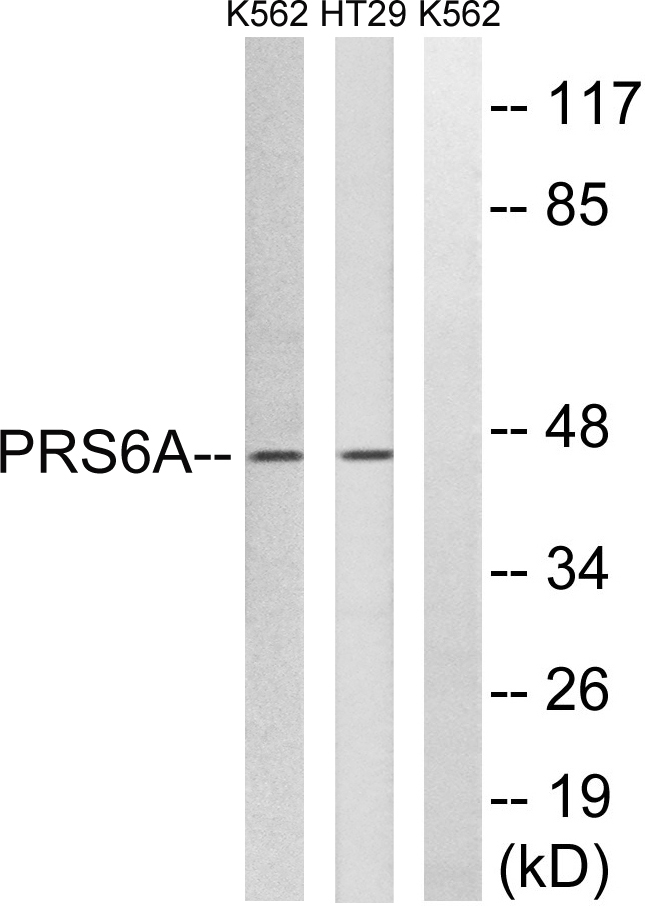PSMC3 Polyclonal Antibody
- Catalog No.:YT3884
- Applications:WB;IHC;IF;ELISA
- Reactivity:Human;Mouse;Rat
- Target:
- PSMC3
- Fields:
- >>Proteasome;>>Alzheimer disease;>>Parkinson disease;>>Amyotrophic lateral sclerosis;>>Huntington disease;>>Spinocerebellar ataxia;>>Prion disease;>>Pathways of neurodegeneration - multiple diseases;>>Epstein-Barr virus infection
- Gene Name:
- PSMC3
- Protein Name:
- 26S protease regulatory subunit 6A
- Human Gene Id:
- 5702
- Human Swiss Prot No:
- P17980
- Mouse Gene Id:
- 19182
- Mouse Swiss Prot No:
- O88685
- Rat Gene Id:
- 29677
- Rat Swiss Prot No:
- Q63569
- Immunogen:
- The antiserum was produced against synthesized peptide derived from human PRS6A. AA range:271-320
- Specificity:
- PSMC3 Polyclonal Antibody detects endogenous levels of PSMC3 protein.
- Formulation:
- Liquid in PBS containing 50% glycerol, 0.5% BSA and 0.02% sodium azide.
- Source:
- Polyclonal, Rabbit,IgG
- Dilution:
- WB 1:500 - 1:2000. IHC 1:100 - 1:300. ELISA: 1:40000.. IF 1:50-200
- Purification:
- The antibody was affinity-purified from rabbit antiserum by affinity-chromatography using epitope-specific immunogen.
- Concentration:
- 1 mg/ml
- Storage Stability:
- -15°C to -25°C/1 year(Do not lower than -25°C)
- Other Name:
- PSMC3;TBP1;26S protease regulatory subunit 6A;26S proteasome AAA-ATPase subunit RPT5;Proteasome 26S subunit ATPase 3;Proteasome subunit P50;Tat-binding protein 1;TBP-1
- Observed Band(KD):
- 45kD
- Background:
- proteasome 26S subunit, ATPase 3(PSMC3) Homo sapiens The 26S proteasome is a multicatalytic proteinase complex with a highly ordered structure composed of 2 complexes, a 20S core and a 19S regulator. The 20S core is composed of 4 rings of 28 non-identical subunits; 2 rings are composed of 7 alpha subunits and 2 rings are composed of 7 beta subunits. The 19S regulator is composed of a base, which contains 6 ATPase subunits and 2 non-ATPase subunits, and a lid, which contains up to 10 non-ATPase subunits. Proteasomes are distributed throughout eukaryotic cells at a high concentration and cleave peptides in an ATP/ubiquitin-dependent process in a non-lysosomal pathway. An essential function of a modified proteasome, the immunoproteasome, is the processing of class I MHC peptides. This gene encodes one of the ATPase subunits, a member of the triple-A family of ATPases that have chaperone-like activity. This subunit may compete with PSMC2 for bindi
- Function:
- function:The 26S protease is involved in the ATP-dependent degradation of ubiquitinated proteins. The regulatory (or ATPase) complex confers ATP dependency and substrate specificity to the 26S complex (By similarity). In case of HIV-1 infection, suppresses Tat-mediated transactivation.,PTM:Sumoylated by UBE2I in response to MEKK1-mediated stimuli.,similarity:Belongs to the AAA ATPase family.,subunit:May form a heterodimer with a related family member. Interacts with PAAF1. Interacts with HIV-1 Tat.,
- Subcellular Location:
- Cytoplasm . Nucleus . Colocalizes with TRIM5 in the cytoplasmic bodies. .
- Expression:
- Adipose tissue,Brain,Cajal-Retzius cell,Fetal brain cortex,Kidney,Lung,Peri
- June 19-2018
- WESTERN IMMUNOBLOTTING PROTOCOL
- June 19-2018
- IMMUNOHISTOCHEMISTRY-PARAFFIN PROTOCOL
- June 19-2018
- IMMUNOFLUORESCENCE PROTOCOL
- September 08-2020
- FLOW-CYTOMEYRT-PROTOCOL
- May 20-2022
- Cell-Based ELISA│解您多样本WB检测之困扰
- July 13-2018
- CELL-BASED-ELISA-PROTOCOL-FOR-ACETYL-PROTEIN
- July 13-2018
- CELL-BASED-ELISA-PROTOCOL-FOR-PHOSPHO-PROTEIN
- July 13-2018
- Antibody-FAQs
- Products Images

- Western blot analysis of lysates from K562 and HT-29 cells, using PRS6A Antibody. The lane on the right is blocked with the synthesized peptide.

- Western blot analysis of the lysates from HT-29 cells using PRS6A antibody.

- Immunohistochemical analysis of paraffin-embedded human liver cancer. 1, Antibody was diluted at 1:200(4° overnight). 2, Tris-EDTA,pH9.0 was used for antigen retrieval. 3,Secondary antibody was diluted at 1:200(room temperature, 45min).



